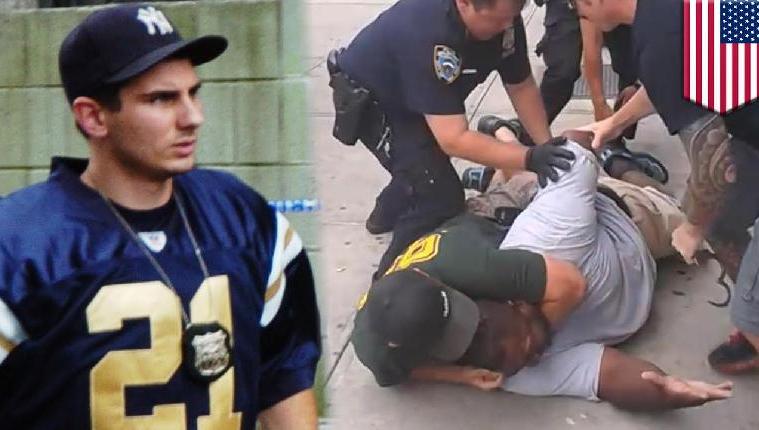
On August 19, NYPD Police Commissioner James O’Neill announced that Daniel Pantaleo’s employment with the NYPD was being terminated. He made his decision based on the recommendation of Deputy Commissioner of Trials, Judge Rosemarie Maldonado, who presided over an in-house bench trial that found Officer Pantaleo guilty of procedural violations during his arrest of Eric Garner. The latter was arrested for allegedly selling single, untaxed cigarettes (“loosies”) on a Staten Island sidewalk July 17, 2014. Because Garner refused to cooperate with the police, the arrest became physical, Garner having to be taken down. He began to plead he couldn’t breathe and went unresponsive, the arrest soon becoming a death in custody. Needless to say, had Garner cooperated with the police from the beginning, the whole sad spectacle—caught on video—never would have had to take place.
"In the pantheon of undead lies, the 'Chokehold Death' has taken its place right up there alongside 'Hands Up, Don’t Shoot.'”
Much of the testimony of the administrative trial revolved around whether the maneuver used to bring Garner to the pavement was a legitimate takedown technique or whether at some point it crossed the line and became a chokehold, which is prohibited by NYPD policy. The medical examiner who performed Garner’s autopsy, Dr. Floriana Persechino, testified that in her opinion—based in part on her viewing of the video—it was a chokehold and that it was this chokehold that set into motion a “lethal cascade of events” culminating in Garner’s experiencing a fatal asthma attack. In the wake of the verdict, there was a bittersweet feeling among many that at least some measure of justice had finally been meted out, albeit too little and too late: Although the grand jury that met after Garner’s death to determine whether criminal charges should be filed against Pantaleo seemingly allowed him to get away with murder, NYPD’s own internal judicial apparatus at least managed to find the rascal guilty of a procedural violation and fire him, albeit five years after the fact.
Curiously absent from media discussion of this decision, however, is why there was absolutely no mention of a fatal asthma attack or a “lethal cascade of events” back when the medical examiner’s office released its initial statement regarding the cause and manner of Garner’s death. That press release gave the cause of death as “compression of neck (chokehold), compression of chest and prone positioning during physical restraint by police”; it gave the manner of death as “homicide.” The only mention of asthma was that it was a “contributing condition” to Garner’s death, along with obesity and cardiovascular disease. Any reasonable person reading that release would have concluded Garner succumbed to the mechanical compression of his neck, which either cut off his air or cut off the flow of oxygenated blood to his brain in conjunction with the interference of his diaphragm’s ability to draw air into his lungs, because of downward pressure being exerted on his prone torso. In other words, any reasonable person would have concluded on the basis of the wording of that release that the NYPD officers had killed Garner, the contributing conditions of his health problems simply enabling the killing to be accomplished in less time and with less effort than would be required for a victim in much better physical condition.
So if Garner had been flat-out killed by a chokehold, why all this business in the administrative trial about a “lethal cascade of events” that led to a fatal asthma attack? But that’s not the half of it: One of the uncontested medical findings listed in the proceedings of the administrative trial was that “the cause of death was not asphyxiation from a chokehold.” Say what? More than likely, these revelations from the administrative trial that seem to be so at odds with the medical examiner’s initial press release had already been brought to the fore during the grand jury trial, whose records were subsequently sealed. During the grand jury trial, the arrest video, the autopsy report, and Dr. Persechino herself were more than likely subjected to intense scrutiny, with the result that the grand jury rightly rejected the assertion that a homicidal chokehold had been applied. One necessary condition for a fatal chokehold is the victim’s loss of consciousness because the brain isn’t getting the oxygen it needs; it is only if the chokehold is maintained for some time after the loss of consciousness that the victim will either die or suffer irreparable brain damage.
The video shows that Garner remained conscious throughout the no more than 16 seconds that Pantaleo had his arm around his neck and that it was only after Pantaleo had taken his arm from around his neck that Garner began to plead he couldn’t breathe. It was obviously something other than Pantaleo’s arm around his neck that was interfering with Garner’s breathing. Prone chest compression? Although deaths in custody have occurred from law enforcement personnel putting their full weight on prone arrestees, the video shows that wasn’t the case here. Pantaleo sprawled on top of Garner for all of about three seconds while rolling him from his side into prone position; the other officers were crouching around Garner or bent over him. Garner wasn’t prone long enough and didn’t have enough pressure exerted on him to produce a fatal outcome. If anything, the arrest video is evidence Garner did not die from a chokehold and prone chest compression, nor was this lost on the grand jury.
Garner died because his airways constricted and became clogged with mucus, which is what occurs during a severe asthma attack; of course, that he was being manhandled by the police at the time didn’t help matters any. So the real cause of death was an asthma attack, his arrest by the police being a possible contributing condition to his death. Dr. Persechino, perhaps yearning to play at social justice warrior, saw only what she wanted to see in the video—as did many—overlooking the crucial details that told against death by chokehold and prone chest compression. Finding herself up against the ropes in court, though, she had to change her story, admitting Garner actually died from an asthma attack, but now maintaining it was the chokehold which set into motion a “lethal cascade of events” that caused the asthma attack. Much of the courtroom wrangling in the administrative trial was over exactly what constituted a chokehold and whether Pantaleo might have actually been employing a takedown technique instead of a chokehold.
The video shows Pantaleo approaching Garner’s back from behind and hooking his right arm up under Garner’s right armpit to clasp the front of Garner’s right shoulder. So far, so good—this looks like the beginning of a setup for a takedown. Pantaleo then slings his left arm up over Garner’s left shoulder such that the back of his left hand comes to rest just under Garner’s chin. Pantaleo pulls Garner backward to bring him down, but they collide with a store window, losing their balance as they come off the plate glass. Pantaleo pulls his right arm out from under Garner’s armpit and clasps both hands together around Garner’s neck to regain purchase and bulldog him all the way down to the pavement. After looking this way and that as if considering his next move, Pantaleo releases his hold around Garner’s neck and begins to reposition himself to assist with the handcuffing; it was just as Pantaleo released his hold around Garner’s neck that Garner began to plead he couldn’t breathe. The autopsy showed no damage to Garner’s windpipe or larynx. There was, however, hemorrhaging in the strap muscles of Garner’s neck, indicating pressure sufficient to cause injury had been applied to those areas.
Now the NYPD Patrol Guide forbids chokeholds, specifying that a chokehold “shall include but is not limited to, any pressure to the throat or windpipe which may prevent or hinder breathing or reduce intake of air.” This definition of chokehold doesn’t preclude the use of a neck hold, so long as it doesn’t cut off the arrestee’s air. However, this definition was later augmented in training material to read “Chokeholds include, but are not limited to, bar arm holds and carotid holds, and any pressure to the throat or windpipe that may prevent or hinder breathing, circulation or reduce intake of air.” According to this definition, virtually any kind of neck hold could be considered a chokehold, and this is what ultimately got Pantaleo fired. He should have stayed away from Garner’s neck altogether. Furthermore, prosecution argued the video showed Pantaleo’s forearm at times positioned on the anterior portion of Garner’s neck, where it could—if even for only a second—possibly interfere with Garner’s breathing and therefore technically meet the definition of chokehold. At one point while Garner was down with Pantleo’s arm still around his neck, he grunted or coughed, and this was taken by the prosecution to be a response to a momentary interruption of air flow. So although Garner may have fleetingly experienced a chokehold, he certainly was not choked to death.
Although asthma attacks can be triggered by physical exertion, they can also be triggered by emotional stress; and sometimes they just come out of the blue. In 2017, Garner’s grown daughter Erica was taken to the hospital after the onset of a severe asthma attack, where she then went into cardiac arrest, suffered irreparable brain damage, and had to be taken off life support. During Pantaleo’s administrative trial, the defense posed a hypothetical situation to Dr. Persechino: What if during the arrest Pantaleo had not touched Garner’s neck at all but had instead grabbed him in a bear hug to effect the arrest? Could that have triggered an asthma attack as well? Dr. Persechino acknowledged that it very well could have.
Well then, let’s take that ball and run with it. What if the highly agitated Garner—so far untouched by the police—had instead finally acquiesced to the arrest, allowing himself to be handcuffed with no resistance, only to experience his fatal asthma attack while being transported to the police station? Would Dr. Persechino still have ruled the manner of death a homicide? After all, it would have been Garner’s confrontation by the police to arrest him that set into motion this “lethal cascade of events” which led to the fatal asthma attack, would it not? Persechino’s lethal cascade rationalization is a slippery slope; she should have simply stated from the very beginning that the cause of Garner’s death was an asthma attack. Had Garner not had an asthma attack during his actual arrest, he would have ended up in jail with scrapes and bruises from being taken down on hard pavement, along with a sore neck, which would have healed with time. He would have lived to sell loosies another day. And again, if Garner had simply complied with the police in the first place, instead of becoming argumentative and working himself up into an agitated state, he likewise would have lived to sell loosies another day.
Contrary to the countless journalistic accounts employing the trope, there was no “chokehold death.” And yet, thanks to CSI-like television programs, medical examiners have been imbued with a kind of invincible infallibility, their pronouncements unquestioningly taken as gospel truth. Hence the public’s willingness to accept the proffered official version of Garner’s cause and manner of death even in the face of video evidence to the contrary. In a state of extreme suggestibility, almost as if in the grip some kind of bizarre medieval mania, millions of Americans—including professional journalists—became part of a hallucinating mob that “saw” things in the Garner arrest video that simply never happened. They “saw” Garner pleading he couldn’t breathe while Pantaleo’s arm was still wrapped around his neck. One journalist reported that Garner “died in a police chokehold,” the hapless Garner giving up the ghost right there with Pantaleo’s arm around his neck. Millions “saw” multiple police officers “piled” on top of Garner, one journalist describing how “hundreds of pounds of cop flesh” pressed down on Garner. They went into a hysterical denunciation of the grand jury’s decision not to indict Pantaleo for a chokehold death the video shows never happened.
It has been said that if a lie is told long enough and often enough, people will come to believe it. The lie seems to take on a life of its own, shambling on even after it has been debunked. Within a month after Eric Garner’s death, a police officer in Ferguson, Missouri, shot and killed Michael Brown in what an extensive investigation later determined to be a justified shooting. Still, die-hard true believers—including recent presidential hopefuls Elizabeth Warren and Kamala Harris—persist in referring to Michael Brown’s death as a murder. It is as if they’re utterly unaware of the exculpatory evidence that cleared Darren Wilson of any wrongdoing. In the pantheon of undead lies, the “Chokehold Death” has taken its place right up there alongside “Hands Up, Don’t Shoot.”

